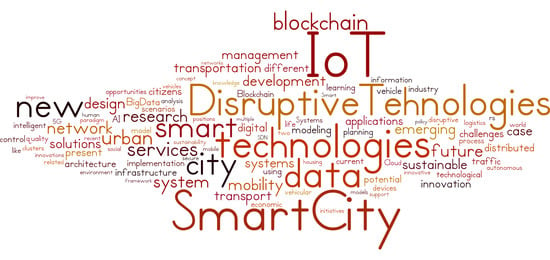Disruptive Technologies in Smart Cities: A Survey on Current Trends and Challenges
Abstract
1. Introduction
2. Background
3. Material and Methods
- (1)
- What are the disruptive technologies that significantly influence the evolution of smart cities?
- (2)
- How can these contribute to the development of smarter cities?
4. Results
4.1. Internet of Things
4.2. Big Data and Artificial Intelligence
4.3. Blockchain
5. Discussion
- The disruptive technologies have the potential to generate positive changes in the smart city by promoting sustainable economic and social activities.
- IoT, AI, and big data are useful in automating decision making and problem solving and support the development of smarter cities.
- Blockchain increases the trust in data proving a secure communication platform and better usage of the legacy infrastructure and resources.
- The literature on disruptive technologies in smart cities associates these technologies, especially with AI, big data, IoT, and blockchain.
- AI, big data, IoT, and blockchain are interdependent and complementary and provide support for all other emerging technologies used in smart cities (wearable tech, social robotics, virtual and augmented reality, 3D printing, digital twins, etc.).
- Disruptive technologies in the actual context of smart cities mainly concentrate on mobility and transport, environmental sustainability, health, security, business efficiency, energy efficiency, and education.
6. Conclusions
Funding
Conflicts of Interest
References
- Caragliu, A.; Del Bo, C.; Nijkamp, P. Smart cities in Europe. J. Urban Technol. 2011, 18, 65–82. [Google Scholar] [CrossRef]
- The World Bank. United Nations Population Division. World Urbanization Prospects: 2018 Revision; The World Bank: Washington, DC, USA, 2020; Available online: https://data.worldbank.org/indicator/SP.URB.TOTL.IN.ZS?end=2019&start=1960&view=chart (accessed on 15 July 2020).
- Knorr, D.; Khoo, C.S.; Augustin, M.A. Food for an urban planet: Challenges and research opportunities. Front. Nutr. 2017, 4, 73. [Google Scholar] [CrossRef]
- Kirimtat, A.; Krejcar, O.; Kertesz, A.; Tasgetiren, M.F. Future Trends and Current State of Smart City Concepts: A Survey. IEEE Access 2020, 8, 86448–86467. [Google Scholar] [CrossRef]
- Lim, C.; Kim, K.; Maglio, P. Smart cities with big data: Reference models, challenges, and considerations. Cities 2018, 82, 86–99. [Google Scholar] [CrossRef]
- Herrera-Quintero, L.F.; Chavarriaga, J.; Banse, K.; Bermudez, D.; Proeller, G. Disruptive Technologies in Intelligent Transportation Systems. In Proceedings of the 2nd Latin American Conference on Intelligent Transportation Systems (ITS LATAM), Bogota, Colombia, 19–20 March 2019; pp. 1–6. [Google Scholar]
- Van Dijk, A.; Teuben, H. Smart Cities: How Rapid Advances in Technology Are Reshaping Our Economy and Society. Available online: https://www2.deloitte.com/content/dam/Deloitte/tr/Documents/public-sector/deloitte-nl-ps-smart-cities-report.pdf (accessed on 8 July 2020).
- Ullah, F.; Sepasgozar, S.; Wang, C. A systematic review of smart real estate technology: Drivers of, and barriers to, the use of digital disruptive technologies and online platforms. Sustainability 2018, 10, 3142. [Google Scholar] [CrossRef]
- Soomro, K.; Bhutta, M.N.M.; Khan, Z.; Tahir, M.A. Smart city big data analytics: An advanced review. Wiley Interdiscip. Rev. Data Min. Knowl. Discov. 2019, 9, 1–25. [Google Scholar] [CrossRef]
- Luque-Vega, L.; Carlos-Mancilla, M.; Payán-Quiñónez, V.; Lopez-Neri, E. Smart Cities Oriented Project Planning and Evaluation Methodology Driven by Citizen Perception—IoT Smart Mobility Case. Sustainability 2020, 12, 7088. [Google Scholar] [CrossRef]
- Bruneckienė, J. The concept of smart economy under the context of creation the economic value in the city. Public Policy Adm. 2014, 13, 469–482. [Google Scholar] [CrossRef]
- Komninos, N.; Pallot, M.; Schaffers, H. Special Issue on Smart Cities and the Future Internet in Europe. J. Knowl. Econ. 2013, 4, 119–134. [Google Scholar] [CrossRef]
- Torre-Bastida, A.; Del Ser, J.; Laña, I.; Ilardia, M.; Bilbao, M.; Campos-Cordobés, S. Big Data for transportation and mobility: Recent advances, trends and challenges. IET Intell. Transp. Syst. 2018, 12, 742–755. [Google Scholar] [CrossRef]
- Hîrţan, L.; Dobre, C.; González-Vélez, H. Blockchain-based reputation for intelligent transportation systems. Sensors 2020, 20, 791. [Google Scholar] [CrossRef] [PubMed]
- Yuan, Y.; Wang, F. Towards blockchain-based intelligent transportation systems. In Proceedings of the International Conference on Intelligent Transportation Systems, Rio de Janeiro, Brazil, 1–4 November 2016; pp. 2663–2668. [Google Scholar]
- Manogaran, G.; Varatharajan, R.; Lopez, D.; Kumar, P.; Sundarasekar, R.; Thota, C. A new architecture of Internet of Things and big data ecosystem for secured smart healthcare monitoring and alerting system. Future Gener. Comput. Syst. 2018, 82, 375–387. [Google Scholar] [CrossRef]
- Lin, C.; He, D.; Kumar, N.; Huang, X.; Vijayakumar, P.; Choo, K. Homechain: A blockchain-based secure mutual authentication system for smart homes. IEEE Internet Things J. 2019, 7, 818–829. [Google Scholar] [CrossRef]
- Voda, I.A.; Radu, L.D. How can artificial intelligence respond to smart cities challenges? In Smart Cities: Issues and Challenges: Mapping Political, Social and Economic Risks and Threats Serves; Visvizi, A., Lytras, M., Eds.; Elsevier: Amsterdam, The Netherlands, 2019; pp. 199–216. [Google Scholar]
- Ullah, Z.; Al-Turjman, F.; Mostarda, L.; Gagliardi, R. Applications of Artificial Intelligence and Machine learning in smart cities. Comput. Commun. 2020, 154, 313–323. [Google Scholar] [CrossRef]
- Hashem, I.; Chang, V.; Anuar, N.; Adewole, K.; Yaqoob, I.; Gani, A.; Ahmed, E.; Chiroma, H. The role of big data in smart city. J. Inf. Manag. 2016, 36, 748–758. [Google Scholar] [CrossRef]
- Beck, R.; Avital, M.; Rossi, M.; Thatcher, J. Blockchain Technology in Business and Information Systems Research. Bus. Inf. Syst. Eng. 2017, 59, 381–384. [Google Scholar] [CrossRef]
- Bhushan, B.; Khamparia, A.; Sagayam, K.; Sharma, S.; Ahad, M.; Debnath, N. Blockchain for smart cities: A review of architectures, integration trends and future research directions. Sustain. Cities Soc. 2020, 61, 102360. [Google Scholar] [CrossRef]
- Talari, S.; Shafie-Khah, M.; Siano, P.; Loia, V.; Tommasetti, A.; Catalão, J. A Review of Smart Cities Based on the Internet of Things Concept. Energies 2017, 10, 421. [Google Scholar] [CrossRef]
- Batty, M.; Axhausen, K.; Giannotti, F.; Pozdnoukhov, A.; Bazzani, A.; Wachowicz, M.; Ouzounis, G.; Portugali, Y. Smart cities of the future. Eur. Phys. J. Special Top. 2012, 214, 481–518. [Google Scholar] [CrossRef]
- Muvuna, J.; Boutaleb, T.; Baker, K.; Mickovski, S. A methodology to model integrated smart city system from the information perspective. Smart Cities 2014, 2, 496–511. [Google Scholar] [CrossRef]
- Chourabi, H.; Nam, T.; Walker, S.; Gil-Garcia, J.R.; Mellouli, S.; Nahon, K.; Pardo, T.; Scholl, H. Understanding smart cities: An integrative framework. In Proceedings of the 2012 45th International Conference on System Sciences, Maui, HI, USA, 4–7 January 2012; pp. 2289–2297. [Google Scholar]
- Neirotti, P.; De Marco, A.; Cagliano, A.; Mangano, G.; Scorrano, F. Current trends in Smart City initiatives: Some stylised facts. Cities 2014, 38, 25–36. [Google Scholar] [CrossRef]
- Statista. Internet of Things (IoT) Spending Worldwide 2023. Statista Research Department. Statista—The Statistics Portal. 2020. Available online: https://www.statista.com/statistics/668996/worldwide-expenditures-for-the-internet-of-things/ (accessed on 6 August 2020).
- Tractica. Artificial Intelligence Market Forecasts. Tacticat 2019. Available online: https://tractica.omdia.com/research/artificial-intelligence-market-forecasts (accessed on 6 August 2020).
- Hassani, H.; Huang, X.; Silva, E. Banking with blockchain-ed big data. J. Manag. Anal. 2018, 5, 256–275. [Google Scholar] [CrossRef]
- Brennan, N.; Subramaniam, N.; van Staden, C. Corporate governance implications of disruptive technology: An overview. Br. Account. Rev. 2019, 51, 100860. [Google Scholar] [CrossRef]
- Byström, H. Blockchains, real-time accounting, and the future of credit risk modeling. Ledger 2019, 4, 40–47. [Google Scholar] [CrossRef]
- Liu, S. Blockchain—Statistics & Facts. Statista—The Statistics Portal. Available online: https://www.statista.com/topics/5122/blockchain/ (accessed on 3 September 2020).
- IDC. IDC Forecasts Revenues for Big Data and Business Analytics Solutions Will Reach $189.1 Billion This Year with Double-Digit Annual Growth Through 2022, International Data Corporation. Available online: https://www.idc.com/getdoc.jsp?containerId=prUS44998419 (accessed on 5 September 2020).
- Huang, M.; Rust, R.; Maksimovic, V. The feeling economy: Managing in the next generation of artificial intelligence (AI). Calif. Manage Rev. 2019, 61, 43–65. [Google Scholar] [CrossRef]
- Cartaxo, B.; Pinto, G.; Soares, S. The role of rapid reviews in supporting decision-making in software engineering practice. In Proceedings of the 22nd International Conference on Evaluation and Assessment in Software Engineering, Christchurch, New Zealand, 28–29 June 2018; pp. 24–34. [Google Scholar]
- Statista. Internet of Things—Number of Connected Devices Worldwide 2015–2025. Available online: https://www.statista.com/statistics/471264/iot-number-of-connected-devices-worldwide (accessed on 31 July 2020).
- Guevara, L.; Auat Cheein, F. The Role of 5G Technologies: Challenges in Smart Cities and Intelligent Transportation Systems. Sustainability 2020, 12, 6469. [Google Scholar] [CrossRef]
- Ervural, B.; Ervural, B. Overview of cyber security in the industry 4.0 era. In Industry 4.0: Managing the Digital Transformation; Ustundag, A., Cevikcan, E., Eds.; Springer International Publishing: Cham, Switzerland, 2018; pp. 267–284. [Google Scholar]
- Baloyi, V.T.; Telukdarie, A. Internet of Things: Opportunity for Disaster Risk Reduction. In Proceedings of the International Conference on Industrial Engineering and Operations Management, Johannesburg, South Africa, 29 October–1 November 2018; pp. 2087–2096. [Google Scholar]
- Autili, M.; Di Salle, A.; Gallo, F.; Pompilio, C.; Tivoli, M. A choreography-based and collaborative road mobility system for l’Aquila city. Future Internet 2019, 11, 132. [Google Scholar] [CrossRef]
- Abbasi, K.; Khan, T.; Haq, I. Hierarchical Modeling of Complex Internet of Things Systems Using Conceptual Modeling Approaches. IEEE Access 2019, 7, 102772–102791. [Google Scholar] [CrossRef]
- Intel. Policy Framework for the Internet of Things (IoT). 2014. Available online: https://www.intel.com/content/dam/www/public/us/en/documents/corporate-information/policy-iot-framework.pdf (accessed on 18 July 2020).
- Aldowah, H.; Rehman, S.; Ghazal, S.; Umar, I. Internet of Things in higher education: A study on future learning. J. Phys. Conf. Ser. 2017, 892, 012017. [Google Scholar] [CrossRef]
- Alharthi, A.; Krotov, V.; Bowman, M. Addressing barriers to big data. Bus. Horiz. 2017, 60, 285–292. [Google Scholar] [CrossRef]
- Nicoletti, B. Platforms for Procurement 4.0. In Procurement 4.0 and the Fourth Industrial Revolution; Palgrave Macmillan: Cham, Switzerland, 2020. [Google Scholar]
- Herraiz Faixó, F.; Arroyo-Cañada, F.J.; López-Jurado, M.P.; Lauroba Pérez, A.M. Digital assets Horizon in smart cities: Urban congestion management by IoT, Blockchain/DLT and human reinforcement. In Modelling and Simulation in Management Sciences. MS-18 2018. Advances in Intelligent Systems and Computing, 1st ed.; Ferrer-Comalat, J.C., Linares-Mustaros, S., Merigó, J.M., Kacprzyk, J., Eds.; Springer International Publishing: Cham, Switzerland, 2020; Volume 894, pp. 63–82. [Google Scholar]
- Krotov, V. The Internet of Things and new business opportunities. Bus. Horiz. 2017, 60, 831–841. [Google Scholar] [CrossRef]
- Gope, P.; Hwang, T. Untraceable Sensor Movement in Distributed IoT Infrastructure. IEEE Sens. J. 2015, 15, 5340–5348. [Google Scholar] [CrossRef]
- Anagnostopoulos, T.; Zaslavsky, A.; Kolomvatsos, K.; Medvedev, A.; Amirian, P.; Morley, J.; Hadjieftymiades, S. Challenges and Opportunities of Waste Management in IoT-Enabled Smart Cities: A Survey. IEEE Trans. Sustain. Energy 2017, 2, 275–289. [Google Scholar] [CrossRef]
- Islam, N.; Marinakis, Y.; Majadillas, M.; Fink, M.; Walsh, S. Here there be dragons, a pre-roadmap construct for IoT service infrastructure. Technol. Forecast. Soc. Chang. 2020, 155, 119073. [Google Scholar] [CrossRef]
- Herrera-Quintero, L.; Vega-Alfonso, J.; Bermúdez, D.; Marentes, L.; Banse, K. TS for Smart Parking Systems, towards the creation of smart city services using IoT and cloud approaches. In Proceedings of the Smart City Symposium, Prague, Czech Republic, 23–24 May 2019; pp. 1–7. [Google Scholar]
- Minoli, D.; Sohraby, K.; Occhiogrosso, B. IoT Considerations, Requirements, and Architectures for Smart Buildings—Energy Optimization and Next-Generation Building Management Systems. IEEE Internet Things J. 2017, 4, 269–283. [Google Scholar] [CrossRef]
- Wang, J.; Ni, M.; Wu, F.; Liu, S.; Qin, J.; Zhu, R. Electromagnetic radiation based continuous authentication in edge computing enabled internet of things. J. Syst. Archit. 2019, 96, 53–61. [Google Scholar] [CrossRef]
- Sikder, A.K.; Acar, A.; Aksu, H.; Uluagac, A.S.A.K.; Conti, M. IoT-enabled smart lighting systems for smart cities. In Proceedings of the 8th Annual Computing and Communication Workshop and Conference, Las Vegas, NV, USA, 8–10 January 2018; pp. 639–645. [Google Scholar]
- Nikitas, A.; Michalakopoulou, K.; Njoya, E.; Karampatzakis, D. Artificial Intelligence, Transport and the Smart City: Definitions and Dimensions of a New Mobility Era. Sustainability 2020, 12, 2789. [Google Scholar] [CrossRef]
- Allam, Z.; Dhunny, Z. On big data, artificial intelligence and smart cities. Cities 2019, 89, 80–91. [Google Scholar] [CrossRef]
- Brady, H. The challenge of big data and data science. Annu. Rev. Political Sci. 2019, 22, 297–323. [Google Scholar] [CrossRef]
- Lovis, C. Unlocking the Power of Artificial Intelligence and Big Data in Medicine. J. Med. Internet Res. 2019, 21, e16607. [Google Scholar] [CrossRef]
- Thakuriah, P.; Tilahun, N.; Zeller, M. Big data and urban informatics: Innovations and challenges to urban planning and knowledge discovery. In Seeing Cities through Big Data: Research, Methods and Applications in Urban Informatics; Thakuriah, P.T., Ed.; Springer International Publishing: Cham, Switzerland, 2017; pp. 11–45. [Google Scholar]
- Kitchin, R. The real-time city? Big data and smart urbanism. GeoJournal 2014, 79, 1–14. [Google Scholar] [CrossRef]
- Colding, J.; Barthel, S.; Sörqvist, P. Wicked problems of smart cities. Smart Cities 2019, 2, 512–521. [Google Scholar] [CrossRef]
- Google Trends. Popularity of Big Data, Machine Learning, IoT and AI. 2020. Available online: https://trends.google.com/trends/explore?date=all&q=big%20data,artificial%20intelligence,IoT,machine%20learning (accessed on 6 August 2020).
- Serrano, W. Digital systems in smart city and infrastructure: Digital as a service. Smart Cities 2018, 1, 134–154. [Google Scholar] [CrossRef]
- Mohanty, S.; Choppali, U.; Kougianos, E. Everything you wanted to know about smart cities: The Internet of Things is the backbone. IEEE Consum. Electron. Mag. 2016, 5, 60–70. [Google Scholar] [CrossRef]
- Thakuriah, P.; Tilahun, N.; Zellner, M. Data Introduction to Seeing Cities Through Big Data: Research, Methods and Applications in Urban Informatics. In Seeing Cities Through Big Data: Research, Methods and Applications in Urban Informatics, 1st ed.; Thakuriah, P., Tilahun, N., Zellner, M., Eds.; Springer International Publishing: New York, NY, USA, 2017; pp. 1–9. [Google Scholar]
- Accenture. Accenture Helps Seattle Police Department Implement Data Analytics Platform. Available online: https://newsroom.accenture.com/news/accenture-helps-seattle-police-department-implement-data-analytics-platform.htm (accessed on 5 September 2020).
- The Guardian. Met Police to Begin Using Live Facial Recognition Cameras in London. Available online: https://www.theguardian.com/technology/2020/jan/24/met-police-begin-using-live-facial-recognition-cameras (accessed on 5 August 2020).
- Sadilek, A.; Kautz, H.; DiPrete, L.; Labus, B.; Portman, E.; Teitel, J.; Silenzio, V. Deploying nEmesis: Preventing Foodborne Illness by Data Mining Social Media. AI Mag. 2017, 38, 37–48. [Google Scholar] [CrossRef]
- Lavalle, A.; Teruel, M.; Maté, A.; Trujillo, J. Improving Sustainability of Smart Cities through Visualization Techniques for Big Data from IoT Devices. Sustainability 2020, 12, 5595. [Google Scholar] [CrossRef]
- Al Nuaimi, E.; Al Neyadi, H.; Mohamed, N.; Al-Jaroodi, J. Applications of big data to smart cities. J. Internet Serv. Appl. 2015, 6, 25. [Google Scholar] [CrossRef]
- Purohit, S.; Bothale, V. RFID based solid waste collection process. In Proceedings of the IEEE Recent Advances in Intelligent Computational Systems, Trivandrum, Kerala, India, 22–24 September 2011; pp. 457–460. [Google Scholar]
- Aguilar, A.; Bonilla-Robles, J.; Díaz, J.; Ochoa, A. Real-time video image processing through GPUs and CUDA and its future implementation in real problems in a Smart City. Int. J. Comb. Optim. Probl. Inform. 2019, 10, 33–49. [Google Scholar]
- Nayak, R.; Behera, M.; Pati, U.; Das, S. Video-based Real-time Intrusion Detection System using Deep-Learning for Smart City Applications. In Proceedings of the International Conference on Advanced Networks and Telecommunications Systems, Goa, India, 16–19 December 2019; pp. 1–6. [Google Scholar]
- Bajaj, R.; Sharma, V. Smart education with artificial intelligence-based determination of learning styles. Procedia Comput. Sci. 2018, 132, 834–842. [Google Scholar] [CrossRef]
- Guo, X.; Shen, Z.; Zhang, Y.; Wu, T. Review on the Application of Artificial Intelligence in Smart Homes. Smart Cities 2019, 2, 402–420. [Google Scholar] [CrossRef]
- Chau, K. A review on integration of artificial intelligence into water quality modelling. Mar. Pollut. Bull. 2006, 52, 726–733. [Google Scholar] [CrossRef] [PubMed]
- Wang, P.; Yao, J.; Wang, G.; Hao, F.; Shrestha, S.; Xue, B.; Peng, Y. Exploring the application of artificial intelligence technology for identification of water pollution characteristics and tracing the source of water quality pollutants. Sci. Total Environ. 2019, 693, 133440. [Google Scholar] [CrossRef] [PubMed]
- De Paz, J.; Bajo, J.; Rodríguez, S.; Villarrubia, G.; Corchado, J. Intelligent system for lighting control in smart cities. Inf. Sci. 2016, 372, 241–255. [Google Scholar] [CrossRef]
- Ajerla, D.; Mahfuz, S.; Zulkernine, F. A real-time patient monitoring framework for fall detection. Wirel. Commun. Mob. Comput. 2019, 2019, 9507938. [Google Scholar] [CrossRef]
- Yigitcanlar, T.; Desouza, K.; Butler, L.; Roozkhosh, F. Contributions and risks of artificial intelligence (AI) in building smarter cities: Insights from a systematic review of the literature. Energies 2020, 13, 1473. [Google Scholar] [CrossRef]
- Iskandaryan, D.; Ramos, F.; Trilles, S. Air Quality Prediction in Smart Cities Using Machine Learning Technologies Based on Sensor Data: A Review. Appl. Sci. 2020, 10, 2401. [Google Scholar] [CrossRef]
- Iqbal, R.; Maniak, T.; Karyotis, C. Intelligent remote monitoring of parking spaces using licensed and unlicensed wireless technologies. IEEE Netw. 2019, 33, 23–29. [Google Scholar] [CrossRef]
- Wang, Z.; Srinivasan, R. A review of artificial intelligence-based building energy use prediction: Contrasting the capabilities of single and ensemble prediction models. Renew. Sustain. Energy Rev. 2017, 75, 796–808. [Google Scholar] [CrossRef]
- Bose, B. Artificial intelligence techniques in smart grid and renewable energy systems: Some example applications. Proc. IEEE 2017, 105, 2262–2273. [Google Scholar] [CrossRef]
- Kopytko, V.; Shevchuk, L.; Yankovska, L.; Semchuk, Z.; Strilchuk, R. Smart home and artificial intelligence as environment for the implementation of new technologies. Traektoriâ Nauk. Path Sci. 2018, 4, 2007–2012. [Google Scholar] [CrossRef]
- Maesa, D.; Mori, P. Blockchain 3.0 applications survey. J. Parallel. Distrib. Comput. 2020, 138, 99–114. [Google Scholar] [CrossRef]
- Marsal-Llacuna, M. Future living framework: Is blockchain the next enabling network? Technol. Forecast. Soc. Chang. 2018, 128, 226–234. [Google Scholar] [CrossRef]
- PWC. Blockchain: The Next Innovation to Make Our Cities Smarter. 2018. Available online: http://ficci.in/study-page.asp?spid=22934§orid=41 (accessed on 5 August 2020).
- Aitzhan, N.; Svetinovic, D. Security and Privacy in Decentralized Energy Trading through Multi-signatures, Blockchain and Anonymous Messaging Streams. IEEE Trans. Dependable Secure Comput. 2016, 15, 1–14. [Google Scholar] [CrossRef]
- Novo, O. Blockchain meets IoT: An architecture for scalable access management in IoT. IEEE Internet Things J. 2018, 5, 1184–1195. [Google Scholar] [CrossRef]
- Xie, J.; Tang, H.; Huang, T.; Yu, F.; Xie, R.; Liu, J.; Liu, Y. A survey of blockchain technology applied to smart cities: Research issues and challenges. IEEE Commun. Surv. Tutor. 2019, 21, 2794–2830. [Google Scholar] [CrossRef]
- Benedict, S.; Rumaise, P.; Kaur, J. IoT Blockchain Solution for Air Quality Monitoring in SmartCities. In Proceedings of the IEEE International Conference on Advanced Networks and Telecommunications Systems, Goa, India, 16–19 December 2019; pp. 1–6. [Google Scholar]
- Lin, Y.-P.; Petway, J.; Anthony, J.; Mukhtar, H.; Liao, S.-W.; Chou, C.-F.; Ho, Y.-F. Blockchain: The Evolutionary Next Step for ICT E-Agriculture. Environments 2017, 4, 50. [Google Scholar] [CrossRef]
- European Commission. On Artificial Intelligence: A European Approach to Excellence and Trust. Available online: https://ec.europa.eu/info/publications/white-paper-artificial-intelligence-european-approach-excellence-and-trust_en (accessed on 6 September 2020).
- Allam, Z.; Newman, P. Redefining the smart city: Culture, metabolism and governance. Smart Cities 2018, 1, 4–25. [Google Scholar] [CrossRef]
- Mattern, S. Methodolatry and the Art of Measure. The New Wave of Urban Data Science. Places J. 2013. Available online: https://placesjournal.org/article/methodolatry-and-the-art-of-measure/?cn-reloaded=1 (accessed on 10 May 2020). [CrossRef]
- Hough, M. Keeping it to ourselves: Technology, privacy, and the loss of reserve. Technol. Soc. 2009, 31, 406–413. [Google Scholar] [CrossRef]
- Georgescu, M.; Popescul, D. The Importance of Internet of Things Security for Smart Cities. Smart Cities Technologies. In Smart Cities Technologies, 1st ed.; Da Silva, I.-N., Flauzino, R.-A., Eds.; IntechOpen: London, UK, 2016; pp. 3–18. [Google Scholar]
- Necula, S.-C.; Păvăloaia, V.-D.; Strîmbei, C.; Dospinescu, O. Enhancement of e-commerce websites with semantic web technologies. Sustainability 2018, 10, 1995. [Google Scholar] [CrossRef]
- Vranken, H. Sustainability of bitcoin and blockchains. Curr. Opin. Environ. Sustain. 2017, 28, 1–9. [Google Scholar] [CrossRef]
- United Nations. 68% of the World Population Projected to Live in Urban Areas by 2050, Says UN; United Nations: New York, NY, USA, 2020; Available online: https://www.un.org/development/desa/en/news/population/2018-revision-of-world-urbanization-prospects.html (accessed on 5 June 2020).
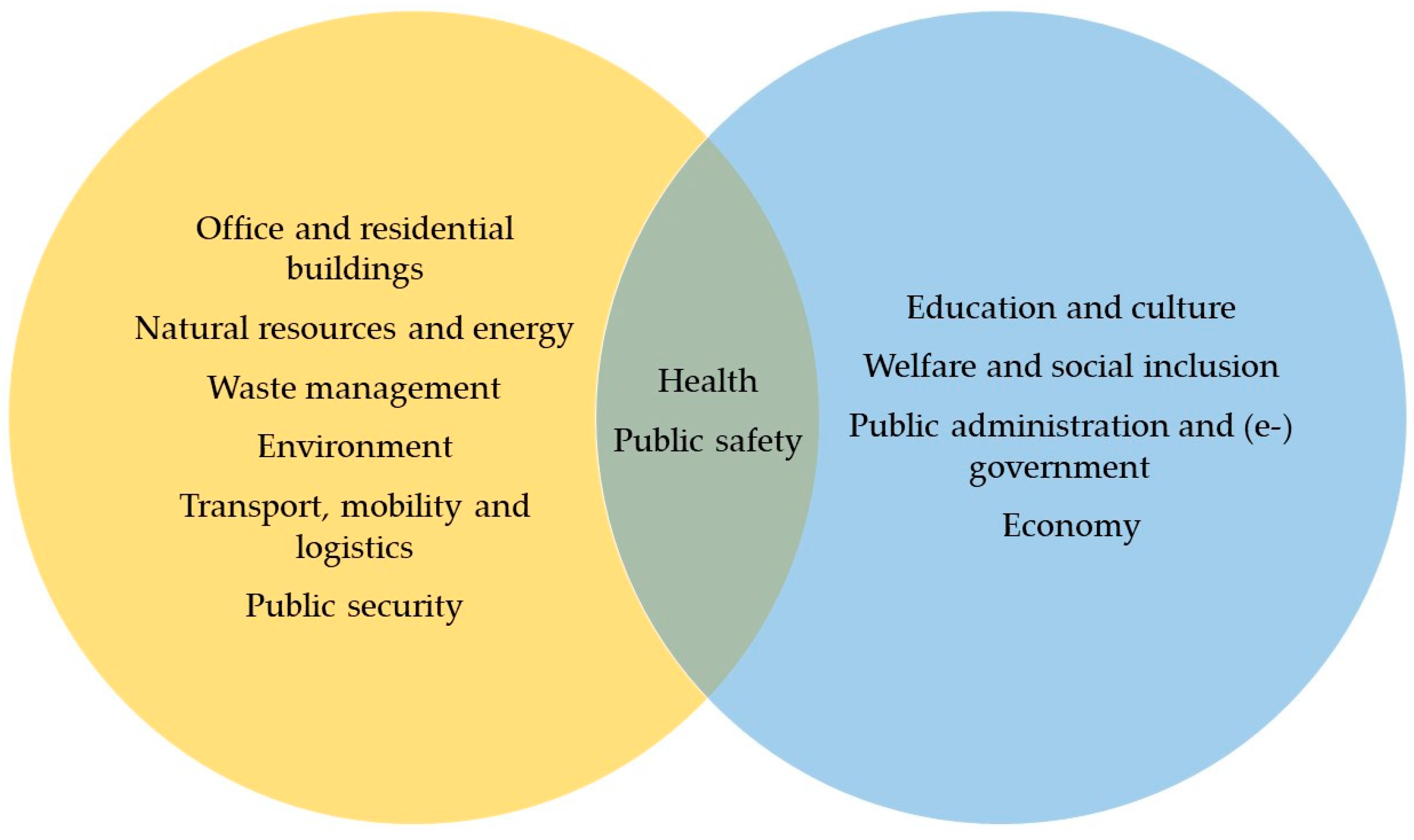
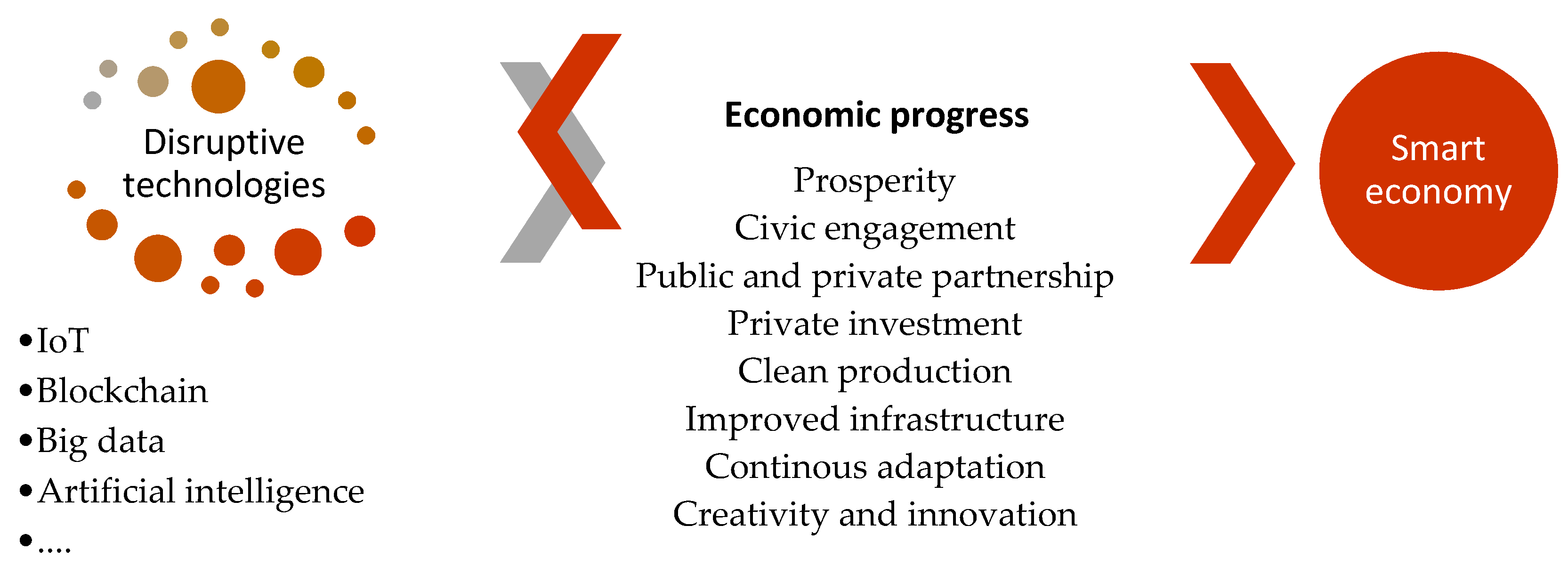
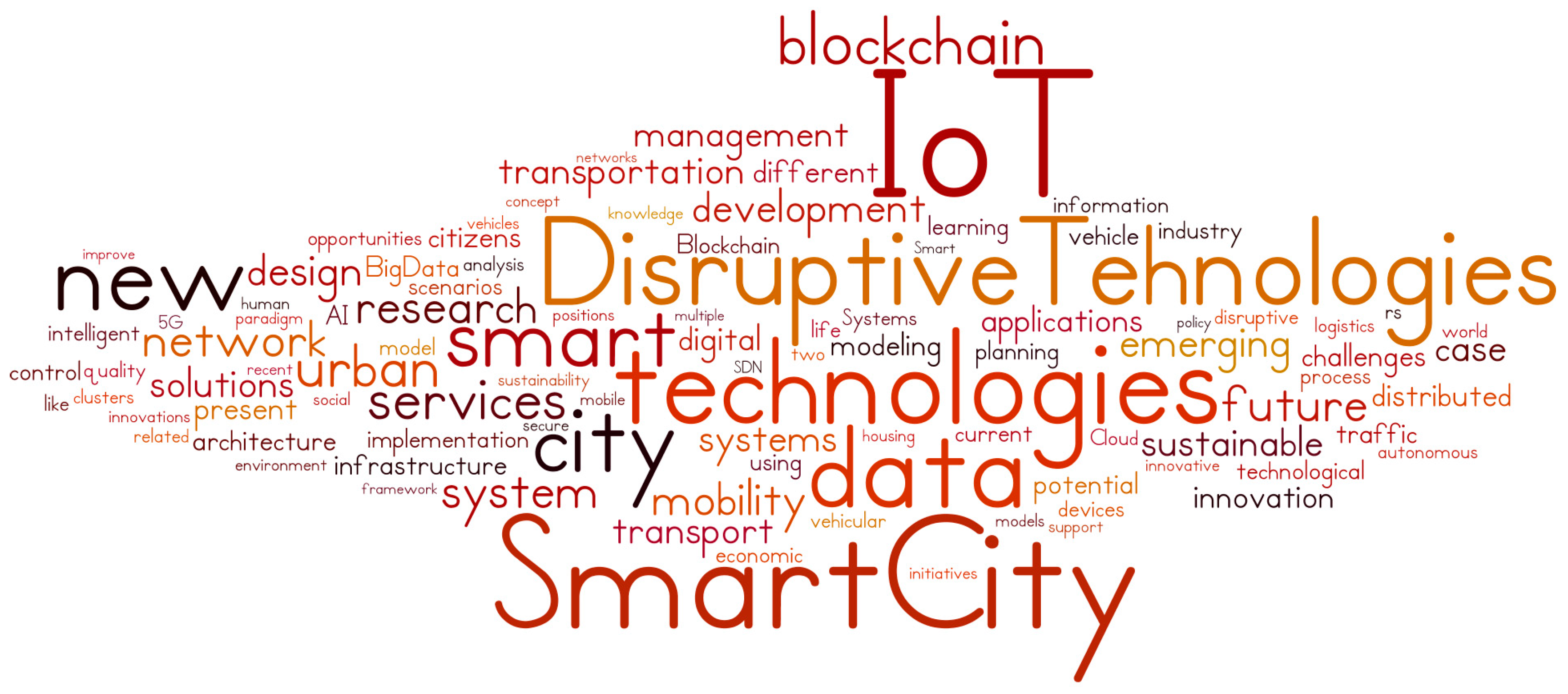
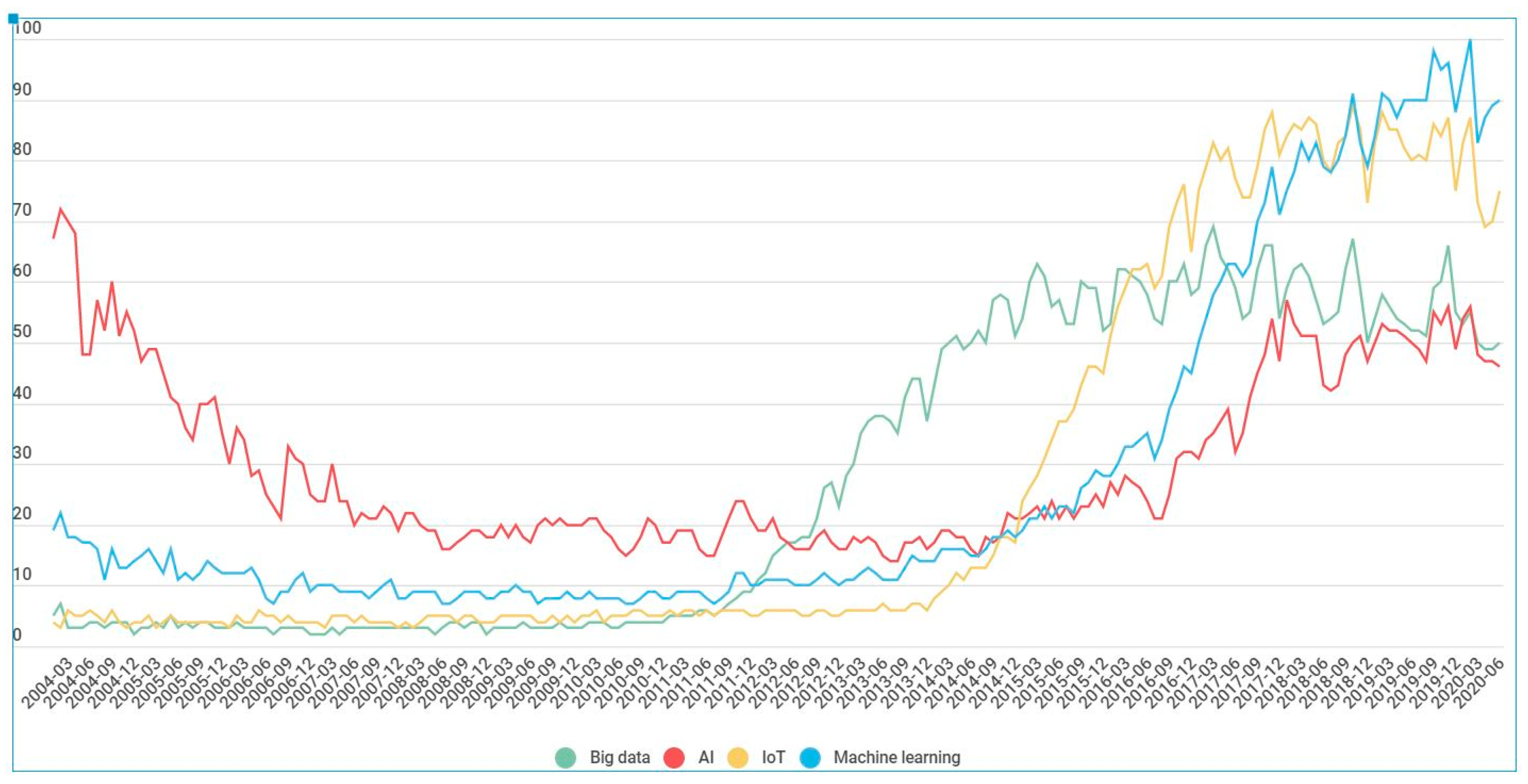
| Database | Query | Number of Papers |
|---|---|---|
| IEEE Xplore | “All Metadata”:”disruptive technolog*” AND “smart cit*” OR “Abstract”:”disruptive technolog*” AND “smart cit*” OR “Document Title”:”disruptive technolog*” AND “smart cit*” | 21 |
| Web of Science | (“disruptive technolog*” AND “smart cit*”) Timespan: All years. Indexes: SCI-EXPANDED, SSCI, A&HCI, CPCI-S, CPCI-SSH, BKCI-S, BKCI-SSH, ESCI, CCR-EXPANDED, IC. | 26 |
| Scopus | TITLE-ABS-KEY (“disruptive technolog*” AND “smart cit*”) AND (LIMIT-TO (DOCTYPE, “cp”) OR LIMIT-TO (DOCTYPE, “ar”) OR LIMIT-TO (DOCTYPE, “re”) OR LIMIT-TO (DOCTYPE, “ch”)) | 42 |
| Smart Economy | Smart Mobility | Smart Governance | Smart People | Smart Living | Smart Environment |
|---|---|---|---|---|---|
| Industry monitoring [10] | Traffic management [11,41] | E-government [43] | Education [44] | Entertainment [23] | Air pollution [45] |
| Infrastructure monitoring | E-procurement [46] | Healthcare [16] | Noise monitoring [23] | ||
| Efficient transportation planning [41,47] | Utility management [23] | Entrepreneurial opportunities [48] | Emergency services [49] | Waste management [50] | |
| Food and agriculture [51] | Smart parking [52] | Defense [18] | Building management [53] | ||
| Radiation and electromagnetic level [54] | Quality of shipment conditions | Public safety [18,23] | Surveillance [23] | Radiation and electromagnetic level [54] | |
| Smart lighting [55] | Public services [43] | ||||
| Efficient energy consumption [4,53] | |||||
| Wine quality | Vehicle auto-diagnosis [56] | Cultural facilities [4] | Smart home and office [17,23] | Forest fire detection [40] | |
| Smart Economy | Smart Mobility | Smart Governance | Smart People | Smart Living | Smart Environment |
|---|---|---|---|---|---|
| Support business decisions [58] | Traffic management [14,19] | E-government [9,61] | Education [75] | Entertainment [76] | Water quality [77,78] |
| Smart lighting [5,79] | Planning [70] | Healthcare [16,80] | Disaster prevention [70] | ||
| Automating the data management process [81] | Transport congestion [9] | E-procurement [46] | Entrepreneurial opportunities [48] | Crowd monitoring [73,74] | Air quality prediction [82] |
| Complex statistical analyses [81] | Smart parking [83] | Public safety [73,74] | Social comfort [57] | Building management [84] | |
| Efficient energy [5,84,85] | |||||
| Perform repetitive tasks [9] | Vehicle auto-diagnosis [9] | Smart home [86] | Waste management [50,72] | ||
| Smart Economy | Smart Mobility | Smart Governance | Smart People | Smart Living | Smart Environment |
|---|---|---|---|---|---|
| Access control system [87] | Vehicles communication management [92] | E-procurement/Smart contracts [46,89] | Personal data management [92] | Air quality monitoring [93] | |
| Shipment tracking [92] | Healthcare [22,92] | ||||
| Transportation planning [14,47] | |||||
| Agriculture [94] | Traffic management [14] | E-voting [89] | Smart home [17,87] | ||
| Transaction history management [92] | Public safety [91] | ||||
| Smart grid energy [22,90] | |||||
© 2020 by the author. Licensee MDPI, Basel, Switzerland. This article is an open access article distributed under the terms and conditions of the Creative Commons Attribution (CC BY) license (http://creativecommons.org/licenses/by/4.0/).
Share and Cite
Radu, L.-D. Disruptive Technologies in Smart Cities: A Survey on Current Trends and Challenges. Smart Cities 2020, 3, 1022-1038. https://doi.org/10.3390/smartcities3030051
Radu L-D. Disruptive Technologies in Smart Cities: A Survey on Current Trends and Challenges. Smart Cities. 2020; 3(3):1022-1038. https://doi.org/10.3390/smartcities3030051
Chicago/Turabian StyleRadu, Laura-Diana. 2020. "Disruptive Technologies in Smart Cities: A Survey on Current Trends and Challenges" Smart Cities 3, no. 3: 1022-1038. https://doi.org/10.3390/smartcities3030051
APA StyleRadu, L.-D. (2020). Disruptive Technologies in Smart Cities: A Survey on Current Trends and Challenges. Smart Cities, 3(3), 1022-1038. https://doi.org/10.3390/smartcities3030051




